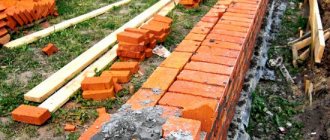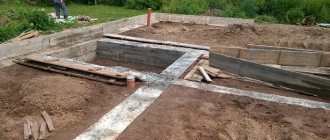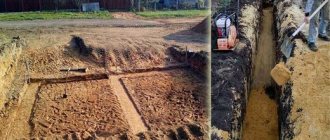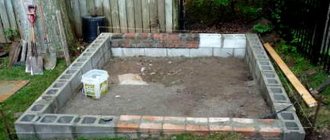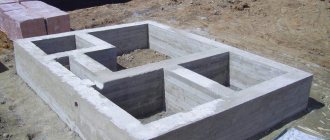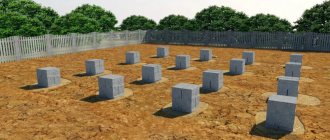A foundation made from FBS blocks has several advantages that no other type of foundation has. FBS (wall foundation block) and FBP (hollow foundation block) are made from light, silicate and heavy concrete, expanded clay concrete. FBS blocks can have a reinforced frame, or have only mounting loops. The ends of the blocks have technological grooves into which cement mortar is placed during installation. Let us consider in detail the construction of a foundation made of FBS blocks.
An important point is that the blocks are produced in standardized sizes; the number of standard sizes is sufficient to form almost any design of strip and column foundations, as well as their variants. The width of the blocks is selected to match the thickness of the building walls.
The need for a foundation cushion
The cushion is necessary to compact the soil under the foundation.
The soil under the base of the foundation sags after the start of economic activity in the building or when it gets wet, thaws and freezes. The result is absolute or average settlement of the structure caused by changes in soil structure.
Damage to foundations occurs in the form of distortions, tilts, shifts and twists. The bedding helps the wall and ceiling structures to operate in the designed position. The house will not collapse, cracks will not appear on the facade of the building.
The backfill is arranged to compact the soil under the foundation and reduce future deformations. The layer helps to distribute forces rhythmically on the base and reduces the rise of soil moisture at the capillary level.
Construction of the foundation cushion
To prevent sand from seeping into the soil, geotextiles are laid.
If the weight of the house is light and they are building a frame type with wooden floor beams, the backfill can be neglected in the case of stable soils or a layer of minimal thickness can be made. The sand cushion for a strip-type foundation is made layer by layer, followed by compaction of all layers.
Rules for arranging a bedding under a monolithic reinforced concrete foundation or slab:
- before compacting, crushed stone or sand is spilled with water so that the elements of the material settle under the influence of gravity;
- the cushion is made under the entire sole of the support, and it must be at least 0.3 meters wider than the tape;
- use purified materials.
Attention is paid to the quality of materials, for example, clay impurities in sand will lead to swelling of the layer when moistened and further freezing. Dusty and fine sands will work similarly, so you should not use them for backfilling, but rather take material of a coarse fraction.
Geotextiles are often used - fabric or non-fabric fabric made of polyester or polypropylene. The fabric is placed on the ground in front of the sand layer so that particles of the material are not washed into the ground and the layer does not swell.
How to buy: price and tips for choosing
The cost of FBS 20x20x40 for a columnar foundation includes the following components:
- price of raw materials;
- cost of production work;
- transportation costs.
The cost of blocks varies from 35 to 75 rubles per piece. The difference in prices is due to a number of reasons:
- weak competition - a small number of production leads to higher prices;
- quality and type of material - hollow expanded clay concrete blocks will be cheaper than solid ones;
- resellers on the market - it is cheaper to purchase building materials from the manufacturer;
- order volume – wholesalers are often given discounts.
When choosing and purchasing, you should pay attention to certain points:
- Compliance with the size and weight of the blocks. If the weight is below the specified value, and the dimensions are normal, this may indicate the presence of empty areas in the blocks or poor-quality compaction of the material. These shortcomings have a bad effect on the strength of FBS, so they should not be used for the foundation of a structure.
- Matching shape and size. Often there are batches made in different shapes and differing in size by up to 0.5 cm. You can check them with a template in the form of a plywood frame with a calibrated hole.
- Compliance with GOST. There should be no cracks or deformations on the FBS blocks.
- Compliance of building materials with the requirements of current regulatory documents. It will be confirmed by the presence of certificates and quality passports.
Types of pillows
Backfills and FL reinforced concrete tapes are considered technically correct methods for constructing artificial substrates for foundations. In difficult cases, gaskets made from stone elements are used, for example, when constructing hydraulic structures.
In private and industrial construction, the following types of materials are used:
- coarse rocks (crushed stone, gravel);
- sand;
- monolithic or precast reinforced concrete.
The variety is selected taking into account the number of floors, the budget of the building, the type of soil, the level of ground moisture and the level of freezing. Sand and crushed stone are available in all regions; these materials reduce the loss of heat into the ground and form a strong and reliable foundation.
If the groundwater has a high pressure, there is a danger of the building supports floating up, so the ground under the base is artificially weighted with a concrete layer. They use ready-made FL foundations from factory blocks or pour a monolith.
From sand
The sand is laid in layers, each layer is compacted.
This base is used for houses whose height does not exceed 1 floor. To effectively compact the soil, use material with a grain size of 1–2 mm; river species or washed from quarries work better.
Advantages of sand substrate:
- good thermal insulation from cold;
- possibility of thorough compaction;
- availability and low cost.
If the moisture level rises high, then artificial fabric is installed. Sometimes the heaving layers are removed completely and replaced with sand. The thickness of the layer is chosen individually, most often it is taken by calculation. The sand is laid in layers, each compacted, and the intermediate thickness of the layer is greater with mechanical compaction than with the manual method.
Sand is formed during the destruction of rocks of great strength and is a loose mixture of grains of quartz mineral. River rocks are distinguished by round, rounded particle shapes.
From crushed stone
Crushed stone cushion
Crushed stone is obtained by crushing rocks, boulders and gravel; the material is heavy (1.8 - 2.8 t/m3). The substrate for the support of the house is strong and stable after compaction. Such layers can be easily laid independently. Crushed stone backfill requires the installation of a coarse sand layer before installation.
The grain size of 20 – 40 mm is most suitable for a reinforcing layer. A crushed stone foundation cushion is used under low-rise buildings made of stone and brick with reinforced concrete floors and coverings.
The thickness of the layer is chosen so that the top level coincides with the level of the base of the foundation support for the building. The top of the bedding is leveled and leveled using a level. This is done in order to maintain the design height of the foundation and not reduce it. If the top of the crushed stone is below the required level, there will be an overconsumption of concrete onto the monolithic strip.
Concrete
Block FL
The concrete base is the most durable, but its cost exceeds previous varieties. The cushion for FBS blocks is made monolithic or prefabricated. Pillow blocks are produced in trapezoidal or rectangular cross-section.
Their parameters:
- height 300 – 500 mm;
- length 800 – 2800 mm.
The blocks are laid on the ground if the soil belongs to the category of sandy bases, or a sand layer 100 - 170 mm thick is made under them. The elements are placed as a continuous strip or placed at intervals into which sand is placed.
In both cases, it is necessary to cover the seams with a subsequent layer of foundation blocks. There are ribbed and hollow versions of prefabricated pillows, but they have not found widespread use. The dimensions of FL blocks are taken according to the design dimensions and according to calculations in the project.
Monolithic spacers are a strip of concrete, which is installed using formwork and reinforced with metal mesh along its entire length. This option is placed under heavily loaded buildings and is used for unstable soils. The width of the base exceeds the transverse dimension of the foundation by 30 cm.
Step-by-step instructions for performing concrete preparation
Preparatory work includes the following steps:
- Calculation part. First, engineering and geological surveys are carried out. Before constructing the foundation and the concrete under it, the depth of groundwater is determined, as well as the level of pressure that the soil will bear on the site of the future building. Based on this data, a construction plan is developed and the type of foundation is selected. The proximity to slopes and the occurrence of large compressive loads during the operation of the building are also taken into account.
- Preparing the construction site for laying the cushion. They move on to it after constructing the pit for the foundation. The fertile layer of dug soil is moved so that it can later be used.
The detailed guide discusses the option of preparing from lean concrete. The material received this name due to its low cement content. Its fragility makes it unsuitable for full-scale construction, but it is perfect for a pillow. Two classes of concrete mixtures are used depending on durability - B7.5 or B15. It is better to choose the first option, since the second contains expanded clay, which complicates the use of the material. To obtain a cubic meter of solution for preparation from B7.5 you need: 160 kg of cement, 2.2 tons of sand, 75 liters of water. The components are thoroughly mixed, then poured onto the area.
Detailed algorithm of actions for installing a preparation made of lean concrete:
- In accordance with the design data, the construction site is marked.
- Trenches are dug to the calculated depth. For foundations using a monolithic slab, a pit is dug.
- The area under the foundation is leveled and approximately 10 cm covered with crushed stone.
- Crushed stone is compacted with a vibrating plate.
- Formwork of the required height is installed. The value of the parameter depends on the thickness of the concrete layer. For optimal placement of reinforcement, the formwork should not be lower than 15 cm and higher than 30 cm.
- The pillow is reinforced with reinforcement using rods with a cross-section of 8 mm or more. A mesh will also work.
- Concrete solution is being prepared.
- The formwork is filled with the mixture to the top edge. The concrete is compacted.
- Reinforcement rods are inserted into the solution, which should protrude 20-30 centimeters above the concrete surface.
The pillow preparation is complete. Before building the foundation, you should wait until the concrete hardens.
When the base is ready, additional processing may be required - drilling holes and leveling. Such work is performed with diamond tools.
Intermediate layer thickness
Construction of a monolithic base
The height of the pillow is always taken after performing the design calculation. To do this, specialists do geological surveys of the soil in the construction region and find soil characteristics. At the sole mark, the average pressure on the ground is perceived, therefore, due to compaction, this force will be less. The load will be taken by the natural base, so the correct choice of layer thickness will prevent the possibility of deformation.
Recommended layer thickness:
- sandy base - 15 - 60 cm;
- crushed stone backfill – 20 – 70 cm:
- concrete monolith - 25 - 50 cm;
- prefabricated elements - 30 - 50 cm.
The thickness of the layer can be reduced through the use of geotextile fabric, which will prevent moisture from entering the base. Combining pillow materials also helps to reduce the size.
Application area
Crushed stone-sand and concrete pads are used as a base for strip foundations when constructing buildings made of brick, concrete, and wood to evenly distribute forces on the soil. Bedding is used if the bearing capacity of the base does not ensure the reliability of the structure and can shift due to the weight of the building or dynamic loads.
Features of application:
- The crushed stone layer is used in residential and commercial construction of multi-story buildings made of various materials. Reliable compaction works flawlessly if the filling and compaction technology is followed.
- A sand cushion is placed in areas where there is no water or drainage is provided. It is used for one-story buildings, since sand does not have a high load-bearing capacity.
- Concrete is a durable material and is therefore used in a variety of conditions.
A foundation plan is made, where the location of the foundation pad is marked, indicating the depth, elevations and dimensions of the foundation pad.
Advantages and disadvantages of a foundation made of FBS blocks
The advantages include:
- Saving time. There is no need to mix concrete, count the amount of consumables, or maintain ideal proportions. FBS installation is carried out quickly and there is no need to worry about the quality of the foundation.
- The manufacturer has provided for all aspects of block installation. Large blocks are equipped with special hooks for easy installation. The products are easier to place in a pit during the construction of multi-story buildings or technically complex objects.
- FSBs are equipped with grooves, which further strengthen the foundation.
- If construction is carried out on unprepared soil or in northern regions, FBS can easily cope with these problems. Chemicals are added to the material to increase resistance to deformation.
Disadvantages when using FBS blocks:
- Price.
- Use of special equipment for installation.
- Great risk of foundation subsidence.
The disadvantages of the material include additional waterproofing and insulation, but today it is difficult to do without this stage.
How to make a pillow under the foundation correctly
Construction of a strip foundation
Dig a trench, then clean and level the bottom of the pit. Next, geotextiles are laid so that the remaining side edges cover the compacted cushion on top.
The following are done in order:
- pour coarse sand, moisten each layer and compact it manually or mechanically;
- medium-sized crushed stone is poured in a design layer and compacted manually or using vibratory rammers;
- sand 20 cm high is poured on top of the crushed stone, then water is poured from a hose so that the particles spill inside and compact the stone layer;
- the free ends of the geofabric are brought to the surface of the pillow.
If the dimensions of the finished prefabricated pillow blocks do not coincide in length with the foundation elements, the supporting elements are placed with a small gap.
